Fractional Calculus for Type 2 Interval-Valued Functions
Abstract
1. Introduction
- (i)
- What can be a fitting mathematical framework for dealing with decision-making problems under joint influences of memory and non-random, non-fuzzy, two-layered impreciseness?
- (ii)
- Is there any existing literature addressing memory and two-layered interval uncertainty together for effective managerial policies?
1.1. Literature on Fuzzy Arithmetic and Calculus
1.2. Literature Associated with Interval-Valued Calculus
1.3. Literature of Type 2 Interval Numbers and Functions
1.4. Literature of Fuzzy Fractional Calculus
1.5. Research Gaps and Motivations
- (i)
- Type 2 interval uncertainty is a mathematical structure for defining he uncertainty of data due to belongingness in given intervals. A type 2 interval extends the sense of uncertainty represented by the traditional interval number, making both ends uncertain. Thus, the newly defined uncertain phenomena may have several suitable applications in decision scenarios associated with mathematical modeling and optimization, as discussed earlier.
- (ii)
- The theory of Type 2 interval-valued calculus become instrumental when the dynamical models are taken into consideration for Type 2 interval uncertainty. We found only few documents addressing Type 2 interval-valued calculus.
- (iii)
- Fractional calculus has undergone advancement compared to Newtonian calculus in that it can address the non-local nature, and, more precisely, the memory-carrying characteristic, in dynamical procedures.
- (iv)
- Therefore, the memory-concerned dynamical model is taken under Type 2 interval-driven uncertainty, and the obligation of Type 2 interval-valued fractional calculus becomes acute.
- (v)
- To date, the theory of fractional calculus for Type 2 interval-valued functions has not been identified in the existing literature.
1.6. Contribution of This Paper
- (i)
- The fractional integral calculus is introduced using Riemann–Liouville definition of a fractional integral for Type 2 interval-valued functions.
- (ii)
- The fractional differential calculus is introduced with both Riemann–Liouville’s and Caputo’s approaches to derivatives in Type 2 interval uncertainty.
- (iii)
- A brief introduction to Laplace transformation for Type 2 interval-valued function is added in this text, which would be instrumental for dealing with systems involving Type 2 interval-valued fractional differential equations.
- (iv)
- Furthermore, an inventory model is analyzed, and memory and uncertain driven phenomena are involved as suitable consequences of the proposed theory.
2. Mathematical Prerequisite
3. R-L Fractional Integral of Type 2 Interval-Valued Functions
4. R-L Fractional Derivative of Type 2 Interval-Valued Functions
- (i)
- , when is -increasing for almost everywhere on .
- (ii)
- , when is -decreasing for almost everywhere on
- (i)
- If both and are either -increasing or -decreasing, then is Type 2 interval-valued Riemann–Liouville gH fractional differentiable almost everywhere on and
- (ii)
- If both and are either -increasing or -decreasing, then is Type 2 interval-valued Riemann–Liouville gH fractional differentiable almost everywhere on and
- (iii)
- If is -increasing and is -decreasing (or is -decreasing and is -increasing), thenand
5. Type 2 Interval-Valued Caputo gH Fractional Derivative
- (i)
- , when is -increasing for almost everywhere on .
- (ii)
- , when is -decreasing for almost everywhere on .
- (i)
- If both and are either -increasing or -decreasing simultaneously, then is Type 2 interval-valued Caputo gH fractional differentiable almost everywhere on and
- (ii)
- If both and are either -increasing or -decreasing, then is Type 2 interval-valued Caputo gH fractional differentiable almost everywhere on , andFurthermore, when either for almost everywhere or for almost everywhere .
- (iii)
- If is -increasing and is -decreasing (or is -decreasing and is -increasing), thenfor almost everywhere .
- (iv)
- If is -increasing and is -decreasing (or is -decreasing and is -increasing), thenFurthermore,, when either for almost everywhere or for almost everywhere .
6. Type 2 Interval-Valued Laplace Transformations
- (i)
- When is Type 2 interval-valued Riemann–Liouville gH fractional differentiable of the first type, then
- (ii)
- When is Type 2 interval-valued Riemann–Liouville gH fractional differentiable of the second type, then
- (i)
- When is a Type 2 interval-valued Riemann–Liouville gH fractional differentiable of the first type, then,Then, we have
- (ii)
- When is Type 2 interval-valued Riemann–Liouville gH fractional differentiable of the second type, then,Then, we have
- (i)
- When is Type 2 interval-valued Caputo gH fractional differentiable of the first type, then
- (ii)
- When is Type 2 interval-valued Caputo gH fractional differentiable of the second type, then
- (i)
- When is Type 2 interval-valued Caputo gH fractional differentiable of the first type, then,Then, we have
- (ii)
- When is Type 2 interval-valued Caputo gH fractional differentiable of the second type, then,Then, we have
7. Application of the Proposed Theory in Memory-Controlled Lot Sizing Policy
7.1. Notations and Hypothesis
- (i)
- The demand during the retail process can be boosted by lowering the retail price. Then, the pricing and associated demand may go through two-layered interval uncertainty. Therefore, the demand () is dependent on the selling price, i.e., , where and are two positive crisp constants and is a T2IN.
- (ii)
- Production is instantaneous and the lead time is zero. For the sake of simplicity, this hypothesis assumes that the replenishment will be executed as soon as the order is placed.
- (iii)
- The decision cycle ends when the inventory level reaches zero. The total consumption of production is equal to the lot size, and therefore, shortages are not allowed.
- (iv)
- The EOQ model is memory-sensitive, i.e., the demand depends on the customer’s memory of the previous experience with the shopkeeper’s behavior, the product’s quality, etc.
7.2. Description of Model
7.3. Numerical Result
7.4. Discussions and Managerial Insights
- (i)
- We consider both cases of Type 2 interval-valued Caputo gH fractional differentiability for the inventory-level function. The most significant distinguishing fact is that the first case produces an uncorrected lot size, but the latter does not, irrespective of the variable memory indices. The obtained lot sizes in the first case must be corrected in order to obtain a Type 2 interval number.
- (ii)
- Table 2 describes the sensitivity of the optimal solution concerning the differential memory index for a fixed integral memory index as unity for Case 1. Table 2 shows that diminishing the differential memory index can enhance the average profit. Table 3 describes the sensitivity of the optimal solution with respect to the integral memory index for a fixed differential memory index as unity for Case 1. Table 3 establishes that the average profit deviates more from the Type 2 interval number as the integral memory index is lowered. That strong integral memory contributes to more imprecision regarding the average profit. Table 4 describes the sensitivity of the optimal solution with respect to both memory indexes for Case 1. Table 4 does not follow any specific pattern in the first three rows. However, the remaining row in that table shows that the average profit decreases as the memory index is lowered simultaneously.
- (iii)
- Table 5 describes the sensitivity of the optimal solution with respect to the differential memory index for a fixed integral memory index as unity for Case 2. Table 5 shows that diminishing the differential memory index can enhance the average profit. Table 6 describes the sensitivity of the optimal solution with respect to the integral memory index for a fixed differential memory index as unity for Case 2. Table 6 establishes that the average profit deviates more from the Type 2 interval number as the integral memory index is lowered. That is, strong integral memory contributes to more imprecision regarding the average profit. Table 7 describes the sensitivity of the optimal solution with respect to both memory indexes for Case 2. The first five rows of Table 7 do not follow any specific pattern. However, the remaining row in that table shows that the average profit decreases as the memory index is lowered simultaneously.
- (iv)
- The second case does not need any correction in the obtained solution. In this sense, the case is preferable to the first for the order quantity model. The smaller values of the memory indices imply stronger memory sense. Thus, the proposed inventory model faces profit reductions due to the presence of hard memory sense.
8. Conclusions
- Human-involved communications in a dynamical decision environment cannot be memory-free.
- Numerous physical phenomena exist, where uncertainties are involved in two-layer senses.
- Fractional calculus can represent the memory of the dynamical system. On the other hand, Type 2 intervals are an adequate mathematical framework to describe two-layered, non-random, and non-fuzzy impreciseness.
- In several engineering and managerial situations, senses of memory and two-layer uncertainties may co-exist. For model formulation and analysis of such managerial phenomena, there is no single theory available in the existing literature. This necessitates the introduction of Type 2 interval-valued fractional calculus.
- A single application in inventory management policy is discussed where memory impact is well addressed. However, the impact of two-layer impreciseness would be made more understandable by adding a sense of scoring and ordering of the obtained numerical data.
- In the proposed application, hypothetical data were used for the numerical simulation. Original data from industries and the management sector would provide better insights into the validation of the proposed theory.
- A research gap exists for the direct use of this theory in dynamical models of diverging perspectives. It necessitates a fresh analytical theory of Type 2 interval-valued fractional differential equations to be used in mathematical modeling in the future.
- As an immediate application of the proposed theory, a simple EOQ model has been discussed. Following this pathway, more insightful inventory and supply chain models and other engineering problems may be considered in the mathematical framework of Type 2 interval-valued fractional calculus.
- On the contrary, other definitions of fractional derivatives, like those of Atangana–Baleanu, Atangana–Baleanu–Caputo, and Caputo–Katugampola, may be analyzed in a Type 2 interval environment for more advancement of Type 2 interval-valued fractional calculus.
Author Contributions
Funding
Data Availability Statement
Conflicts of Interest
References
- Zaslavsky, G.M. Hamiltonian Chaos and Fractional Dynamics; Oxford University Press: Oxford, MI, USA, 2005. [Google Scholar]
- Tarasov, V.E. Fractional Dynamics: Applications of Fractional Calculus to Dynamics of Particles, Fields and Media; Springer: New York, NY, USA, 2010. [Google Scholar]
- Luo, A.C.; Afraimovich, V. (Eds.) Long-Range Interactions, Stochasticity and Fractional Dynamics: Dedicated to George M. Zaslavsky (1935–2008); Springer Science & Business Media: Berlin, Germany, 2011. [Google Scholar]
- Baleanu, D.; Diethelm, K.; Scalas, E.; Trujillo, J.J. Fractional Calculus: Models and Numerical Methods; World Scientific: Singapore, 2012; Volume 3. [Google Scholar]
- Du, M.; Wang, Z.; Hu, H. Measuring memory with the order of fractional derivative. Sci. Rep. 2013, 3, 3431. [Google Scholar] [CrossRef]
- Day, W.A. The Thermodynamics of Simple Materials with Fading Memory; Springer: Berlin, Germany, 1972. [Google Scholar]
- Lokshin, A.A.; Suvorova, Y.V. Mathematical Theory of Wave Propagation in Media with Memory; Moscow State University: Moscow, Russia, 1982; p. 152. [Google Scholar]
- Alber, H.D. Initial-Boundary Value Problems for the Inelastic Behavior of Metals. In Materials with Memory. Lecture Notes in Mathematics; Springer: Berlin, Germany, 1998; p. 1682. [Google Scholar]
- Mainardi, F. Fractional Calculus and Waves in Linear Viscoelasticity: An Introduction to Mathematical Models; World Scientific: Singapore, 2010. [Google Scholar]
- Hajipour, M.; Jajarmi, A.; Baleanu, D.; Sun, H. On an accurate discretization of a variable-order fractional reaction-diffusion equation. Commun. Nonlinear Sci. Numer. Simul. 2019, 69, 119–133. [Google Scholar] [CrossRef]
- Meng, R.; Yin, D.; Drapaca, C.S. Variable-order fractional description of compression deformation of amorphous glassy polymers. Comput. Mech. 2019, 64, 163–171. [Google Scholar] [CrossRef]
- Baleanu, D.; Jajarmi, A.; Bonyah, E.; Hajipour, M. New aspects of poor nutrition in the life cycle within the fractional calculus. Adv. Differ. Equ. 2018, 2018, 1–14. [Google Scholar] [CrossRef]
- Baleanu, D.; Jajarmi, A.; Hajipour, M. On the nonlinear dynamical systems within the generalized fractional derivatives with Mittag-Leffler kernel. Nonlinear Dyn. 2018, 94, 397–414. [Google Scholar] [CrossRef]
- Zadeh, L.A. Fuzzy sets. Info. Control. 1965, 8, 338–353. [Google Scholar] [CrossRef]
- Hansen, E. (Ed.) Topics in Interval Analysis; Oxford Clarendon Press: Oxford, UK, 1969; p. 23. [Google Scholar]
- Moore, R.E. Interval Analysis; Prentice-Hall: Englewood Cliff, NJ, USA, 1966. [Google Scholar]
- Rahman, M.S.; Shaikh, A.A.; Bhunia, A.K. On the space of Type-2 interval with limit, continuity and differentiability of Type-2 interval-valued functions. arXiv 2019, arXiv:1907.00644. [Google Scholar]
- Dubois, D. Fuzzy Sets and Systems: Theory and Applications; Academic Press: Cambridge, MA, USA, 1980. [Google Scholar]
- Chang, S.L.; Zadeh, L.A. On fuzzy mapping and control. IEEE Trans. Syst. Man Cybern. 1972, 2, 30–34. [Google Scholar] [CrossRef]
- Chen, S.J.; Hwang, C.L. Fuzzy Multiple Attribute Decision Making; Springer: Berlin, Germany, 1992. [Google Scholar]
- Saha, A.; Dabic-Miletic, S.; Senapati, T.; Simic, V.; Pamucar, D.; Ala, A.; Arya, L. Fermatean Fuzzy Dombi Generalized Maclaurin Symmetric Mean Operators for Prioritizing Bulk Material Handling Technologies. Cogn. Comput. 2024, 16, 1–26. [Google Scholar] [CrossRef]
- Ala, A.; Goli, A.; Mirjalili, S.; Simic, V. A fuzzy multi-objective optimization model for sustainable healthcare supply chain network design. Appl. Soft Comput. 2024, 150, 111012. [Google Scholar] [CrossRef]
- Goetschel Jr, R.; Voxman, W. Elementary fuzzy calculus. Fuzzy Sets Syst. 1986, 18, 31–43. [Google Scholar] [CrossRef]
- Kaleva, O. Fuzzy differential equations. Fuzzy Sets Syst. 1987, 24, 301–317. [Google Scholar] [CrossRef]
- Bede, B. A note on two-point boundary value problems associated with nonlinear fuzzy differential equations. Fuzzy Sets Syst. 2016, 157, 986–989. [Google Scholar] [CrossRef]
- Bede, B.; Rudas, I.J.; Bencsik, A.L. First order linear fuzzy differential equations under generalized differentiability. Inf. Sci. 2007, 177, 1648–1662. [Google Scholar] [CrossRef]
- Bede, B.; Gal, S.G. Generalizations of the differentiability of fuzzy –number-valued functions with applications to fuzzy differential equations. Fuzzy Sets Syst. 2005, 151, 581–599. [Google Scholar] [CrossRef]
- Keshavarz, M.; Allahviranloo, T.; Abbasbandy, S.; Modarressi, M.H. A study of fuzzy methods for solving system of fuzzy differential equations. New Math. Nat. Comput. 2021, 17, 1–27. [Google Scholar] [CrossRef]
- Buckley, J.J.; Feuring, T. Fuzzy differential equations. Fuzzy Sets Syst. 2000, 110, 43–54. [Google Scholar] [CrossRef]
- Buckley, J.J.; Feuring, T. Fuzzy initial value problem for n-th order linear differential equations. Fuzzy Sets Syst. 2001, 121, 247–255. [Google Scholar] [CrossRef]
- Stefanini, L.; Bede, B. Generalized Hukuhara differentiability of interval-valued functions and interval differential equations. Nonlinear Anal. Theory Meth. Appl. 2009, 71, 1311–1328. [Google Scholar] [CrossRef]
- Malinowski, M.T. Interval differential equations with a second type Hukuhara derivative. Appl. Math. Lett. 2011, 24, 2118–2123. [Google Scholar] [CrossRef]
- Chalco-Cano, Y.; Flores-Franulič, A.; Román-Flores, H. Ostrowski type inequalities for interval-valued functions using generalized Hukuhara derivative. Comput. Appl. Math. 2012, 31, 457–472. [Google Scholar]
- Chalco-Cano, Y.; Rufián-Lizana, A.; Román-Flores, H.; Jiménez-Gamero, M.D. Calculus for interval-valued functions using generalized Hukuhara derivative and applications. Fuzzy Sets Syst. 2013, 219, 49–67. [Google Scholar] [CrossRef]
- Chalco-Cano, Y.; Lodwick, W.A.; Rufián-Lizana, A. Optimality conditions of type KKT for optimization problem with interval-valued objective function via generalized derivative. Fuzzy Optim. Decis. Mak. 2013, 12, 305–322. [Google Scholar] [CrossRef]
- Chalco-Cano, Y.; Lodwick, W.A.; Condori-Equice, W. Ostrowski type inequalities and applications in numerical integration for interval-valued functions. Soft Comput. 2015, 19, 3293–3300. [Google Scholar] [CrossRef]
- Ngo, H.V.; Phu, N.D.; Tung, T.T.; Quang, L.T. Interval-valued functional integro-differential equations. Adv. Differ. Equ. 2014, 2014, 1–20. [Google Scholar]
- Ngo, H.V. The initial value problem for interval-valued second-order differential equations under generalized H-differentiability. Inf. Sci. 2015, 311, 119–148. [Google Scholar]
- Román-Flores, H.; Chalco-Cano, Y.; Lodwick, W. Some integral inequalities for interval-valued functions. Comput. Appl. Math. 2018, 37, 1306–1318. [Google Scholar] [CrossRef]
- Tao, J.; Zhang, Z. Properties of interval-valued function space under the gH-difference and their application to semi-linear interval differential equations. Adv. Differ. Equ. 2016, 2016, 1–45. [Google Scholar] [CrossRef]
- Lupulescu, V. Hukuhara differentiability of interval-valued functions and interval differential equations on time scales. Inf. Sci. 2013, 248, 50–67. [Google Scholar] [CrossRef]
- Chalco-Cano, Y.; Costa, T.M.; Román-Flores, H.; Rufián-Lizana, A. New properties of the switching points for the generalized Hukuhara differentiability and some results on calculus. Fuzzy Sets Syst. 2021, 404, 62–74. [Google Scholar] [CrossRef]
- Lupulescu, V. Fractional calculus for interval-valued functions. Fuzzy Sets Syst. 2015, 265, 63–85. [Google Scholar] [CrossRef]
- Ma, W.; Li, X. Fractional calculus of interval-valued functions on time scales. Chin. J. Phys. 2024, 89, 1827–1840. [Google Scholar] [CrossRef]
- Beigmohamadi, R.; Khastan, A. Interval discrete fractional calculus and its application to interval fractional difference equations. Iran. J. Fuzzy Syst. 2021, 18, 151–166. [Google Scholar]
- Ngo, H.V. Existence results for extremal solutions of interval fractional functional integro-differential equations. Fuzzy Sets Syst. 2018, 347, 29–53. [Google Scholar] [CrossRef]
- Ngo, H.V.; Lupulescu, V.; O’Regan, D. Solving interval-valued fractional initial value problems under Caputo gH-fractional differentiability. Fuzzy Sets Syst. 2017, 309, 1–34. [Google Scholar]
- Ho, V. Non-instantaneous impulses interval-valued fractional differential equations with Caputo-Katugampola fractional derivative concept. Fuzzy Sets Syst. 2021, 404, 111–140. [Google Scholar] [CrossRef]
- Huang, L.L.; Liu, B.Q.; Baleanu, D.; Wu, G.C. Numerical solutions of interval-valued fractional nonlinear differential equations. Euro. Phys. J. Plus. 2019, 134, 220. [Google Scholar] [CrossRef]
- Rahman, M.S.; Duary, A.; Shaikh, A.A.; Bhunia, A.K. An application of parametric approach for interval differential equation in inventory model for deteriorating items with selling-price-dependent demand. Neural Comput. Appl. 2020, 32, 14069–14085. [Google Scholar] [CrossRef]
- Rahman, M.S.; Shaikh, A.A.; Bhunia, A.K. On Type-2 interval with interval mathematics and order relations: Its applications in inventory control. Int. J. Syst. Sci. Oper. Logis. 2021, 8, 283–295. [Google Scholar] [CrossRef]
- Rahman, M.S.; Shaikh, A.A.; Ali, I.; Bhunia, A.K.; Fügenschuh, A. A theoretical framework for optimality conditions of nonlinear type-2 interval-valued unconstrained and constrained optimization problems using type-2 interval order relations. Mathematics 2021, 9, 908. [Google Scholar] [CrossRef]
- Rahman, M.S.; Duary, A.; Shaikh, A.A.; Bhunia, A.K. An application of real coded Self-organizing Migrating Genetic Algorithm on a two-warehouse inventory problem with Type-2 interval valued inventory costs via mean bounds optimization technique. Appl. Soft Comput. 2022, 124, 109085. [Google Scholar] [CrossRef]
- Das, S.; Rahman, M.S.; Mahato, S.K.; Shaikh, A.A.; Bhunia, A.K. On the Parametric Representation of Type-2 Interval and Ranking: Its Application in the Unconstrained Nonlinear Programming Problem Under Type-2 Interval Uncertainty. In Computational Modelling in Industry 4.0: A Sustainable Resource Management Perspective; Springer Nature: Singapore, 2022; pp. 281–297. [Google Scholar]
- Rahaman, M.; Mondal, S.P.; Alam, S.; Metwally, A.S.M.; Salahshour, S.; Salimi, M.; Ahmadian, A. Manifestation of interval uncertainties for fractional differential equations under conformable derivative. Chaos Soliton Fract. 2022, 165, 112751. [Google Scholar] [CrossRef]
- Rahaman, M.; Das, M.; Mondal, S.P.; Alam, S. Metric space and calculus of Type 2 interval valued functions. J. Uncert. Syst. 2024; in press. [Google Scholar] [CrossRef]
- Rahaman, M.; Haque, R.; Alam, S.; Zupok, S.; Salahshour, S.; Azizzadeh, F.; Mondal, S.P. Solvability Criteria for Uncertain Differential Equations and Their Applicability in an Economic Lot-Size Model with a Type-2 Interval Phenomenon. Symmetry 2023, 15, 1883. [Google Scholar] [CrossRef]
- Agarwal, R.P.; Lakshmikantham, V.; Nieto, J.J. On the concept of solution for fractional differential equations with uncertainty. Nonlinear Anal. Theo, Meth. Appl. 2010, 72, 2859–2862. [Google Scholar] [CrossRef]
- Arshad, S.; Lupulescu, V. On the fractional differential equations with uncertainty. Nonlinear Anal. Theo. Meth. Appl. 2011, 74, 3685–3693. [Google Scholar] [CrossRef]
- Al-Smadi, M.; Arqub, O.A.; Zeidan, D. Fuzzy fractional differential equations under the Mittag-Leffler kernel differential operator of the ABC approach: Theorems and applications. Chaos Soliton Fract. 2021, 146, 110891. [Google Scholar] [CrossRef]
- Mukherjee, S.; Kumar, A.; Kumbhakar, S. Numerical simulation of fuzzy fractional differential equations using a reliable technique. J. Fuzzy Ext. Appl. 2024, 5, 159–172. [Google Scholar]
- Allahviranloo, T.; Ahmadi, M.B. Fuzzy Laplace transforms. Soft Comput. 2010, 14, 235–243. [Google Scholar] [CrossRef]
- Babakordi, F.; Allahviranloo, T.; Shahriari, M.R.; Catak, M. Fuzzy Laplace transform method for a fractional fuzzy economic model based on market equilibrium. Inf. Sci. 2024, 665, 120308. [Google Scholar] [CrossRef]
- Ahmad, M.Z.; Hasan, M.K.; Abbasbandy, S. Solving fuzzy fractional differential equations using Zadeh’s extension principle. Sci. World J. 2013, 2013, 454969. [Google Scholar] [CrossRef]
- Allahviranloo, T.; Armand, A.; Gouyandeh, Z. Fuzzy fractional differential equations under generalized fuzzy Caputo derivative. J. Intell. Fuzzy Syst. 2014, 26, 1481–1490. [Google Scholar] [CrossRef]
- Van Hoa, N.; Vu, H.; Duc, T.M. Fuzzy fractional differential equations under Caputo–Katugampola fractional derivative approach. Fuzzy Sets Syst. 2019, 375, 70–99. [Google Scholar]
- Allahviranloo, T.; Ghanbari, B. On the fuzzy fractional differential equation with interval Atangana–Baleanu fractional derivative approach. Chaos Soliton Fract. 2020, 130, 109397. [Google Scholar] [CrossRef]
- Sajedi, L.; Eghbali, N.; Aydi, H. Impulsive coupled system of fractional differential equations with Caputo–Katugampola fuzzy fractional derivative. J. Math. 2021, 2021, 1–13. [Google Scholar] [CrossRef]
- Vu, H.; Ghanbari, B.; Van Hoa, N. Fuzzy fractional differential equations with the generalized Atangana-Baleanu fractional derivative. Fuzzy Sets Syst. 2022, 429, 1–27. [Google Scholar] [CrossRef]
- Akram, M.; Muhammad, G. Analysis of in commensurate multi-order fuzzy fractional differential equations under strongly generalized fuzzy Caputo’s differentiability. Granul. Comput. 2023, 8, 809–825. [Google Scholar] [CrossRef]
- Akram, M.; Muhammad, G.; Ahmad, D. Analytical solution of the Atangana–Baleanu–Caputo fractional differential equations using Pythagorean fuzzy sets. Granul. Comput. 2023, 8, 667–687. [Google Scholar] [CrossRef]
- Allahviranloo, T.; Noeiaghdam, Z.; Noeiaghdam, S.; Nieto, J.J. A fuzzy method for solving fuzzy fractional differential equations based on the generalized fuzzy Taylor expansion. Mathematics 2020, 8, 2166. [Google Scholar] [CrossRef]
- Shiri, B.; Alijani, Z.; Karaca, Y. A power series method for the fuzzy fractional logistic differential equation. Fractals 2023, 31, 2340086. [Google Scholar] [CrossRef]
- Askari, S.; Allahviranloo, T.; Abbasbandy, S. Solving fuzzy fractional differential equations by adomian decomposition method used in optimal control theory. Int. Trans. J. Eng. Manage. Appl. Sci. Tech. 2019, 10, 1–10. [Google Scholar]
- Van, H.N.; Ho, V. A survey on the initial value problems of fuzzy implicit fractional differential equations. Fuzzy Sets Syst. 2020, 400, 90–133. [Google Scholar]
- Van Ngo, H.; Lupulescu, V.; O’Regan, D. A note on initial value problems for fractional fuzzy differential equations. Fuzzy Sets Syst. 2018, 347, 54–69. [Google Scholar]
- An, T.V.; Phu, N.D.; Van Hoa, N. A survey on non-instantaneous impulsive fuzzy differential equations involving the generalized Caputo fractional derivative in the short memory case. Fuzzy Sets Syst. 2022, 443, 160–197. [Google Scholar] [CrossRef]
- Pakhira, R.; Ghosh, U.; Sarkar, S. Study of memory effect in a fuzzy EOQ model with no shortage. Int. J. Intel. Syst. Appl. 2019, 10, 58. [Google Scholar] [CrossRef]
- Kilbas, A.A.; Srivastava, H.M.; Trujillo, J.J. Theory and Applications of Fractional Differential Equations; Elsevier: Ameserdam, The Netherlands, 2006; Volume 204. [Google Scholar]
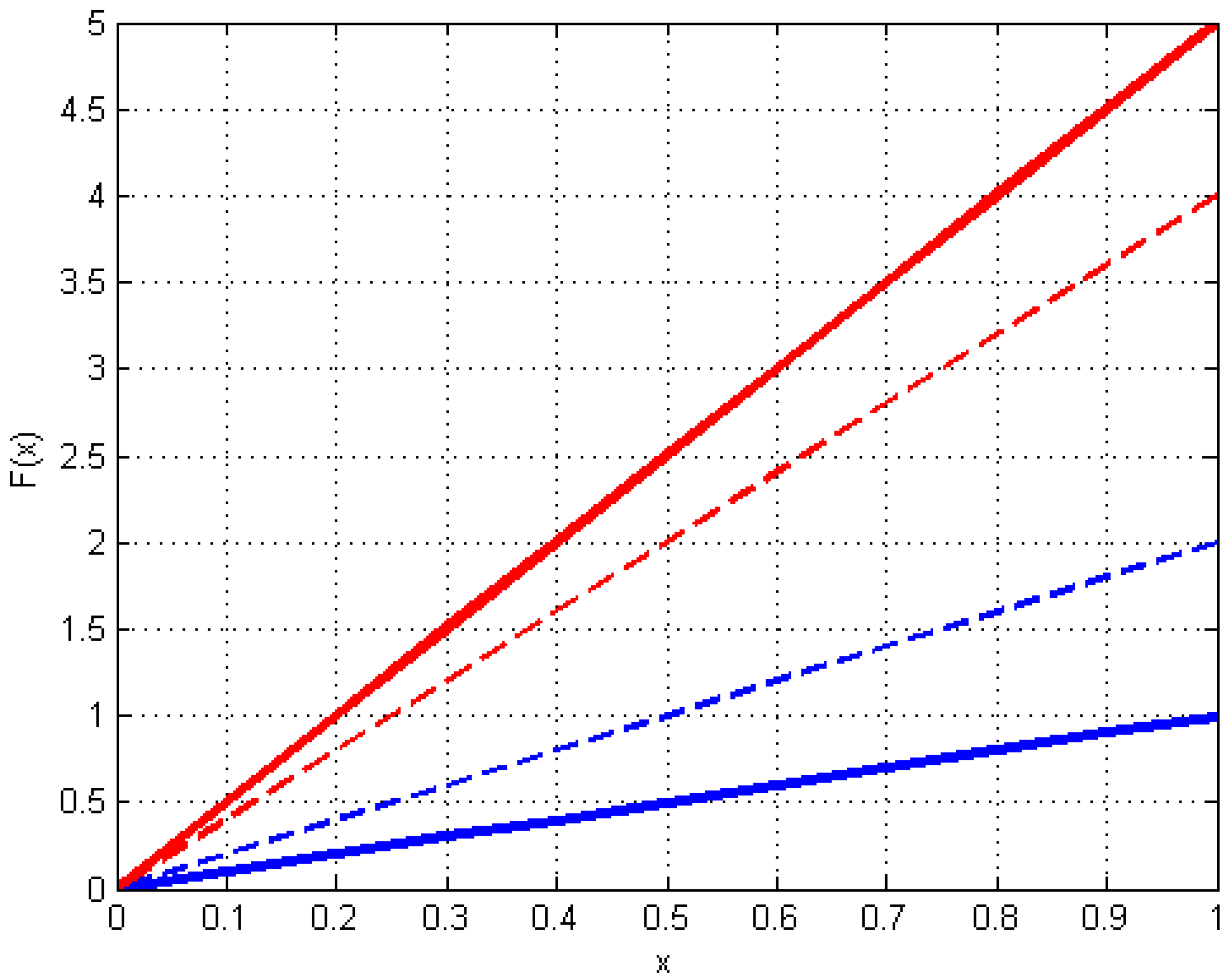
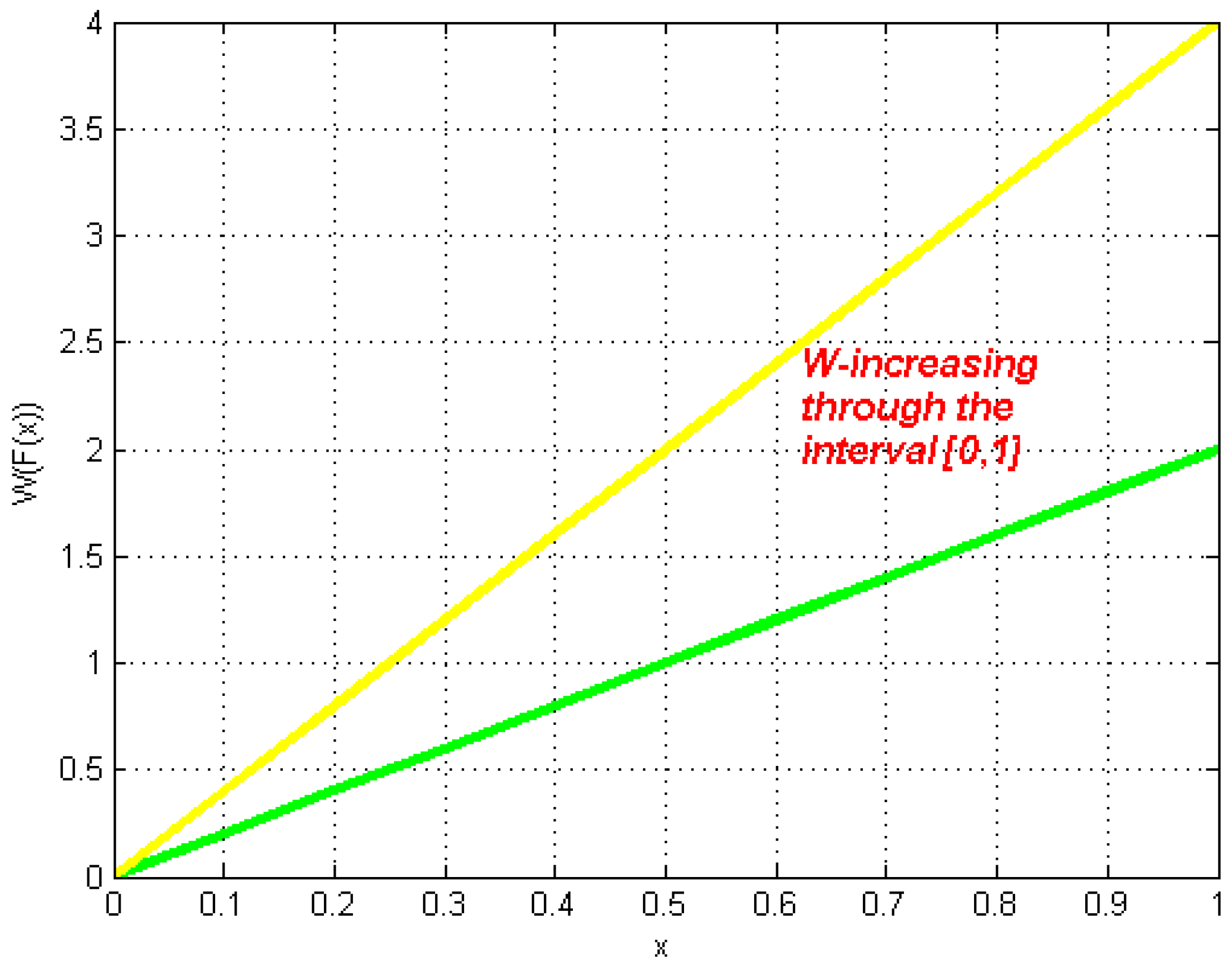
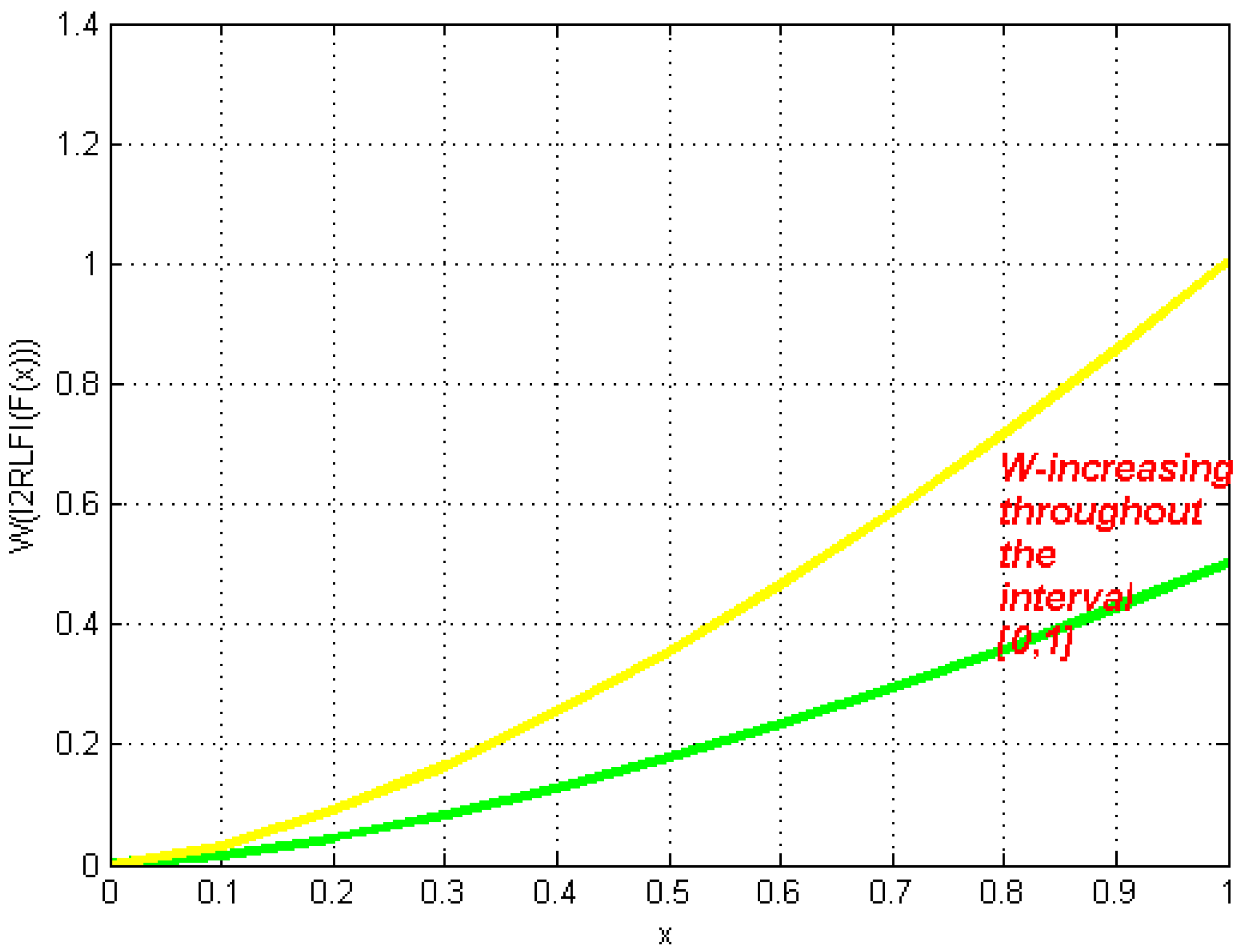
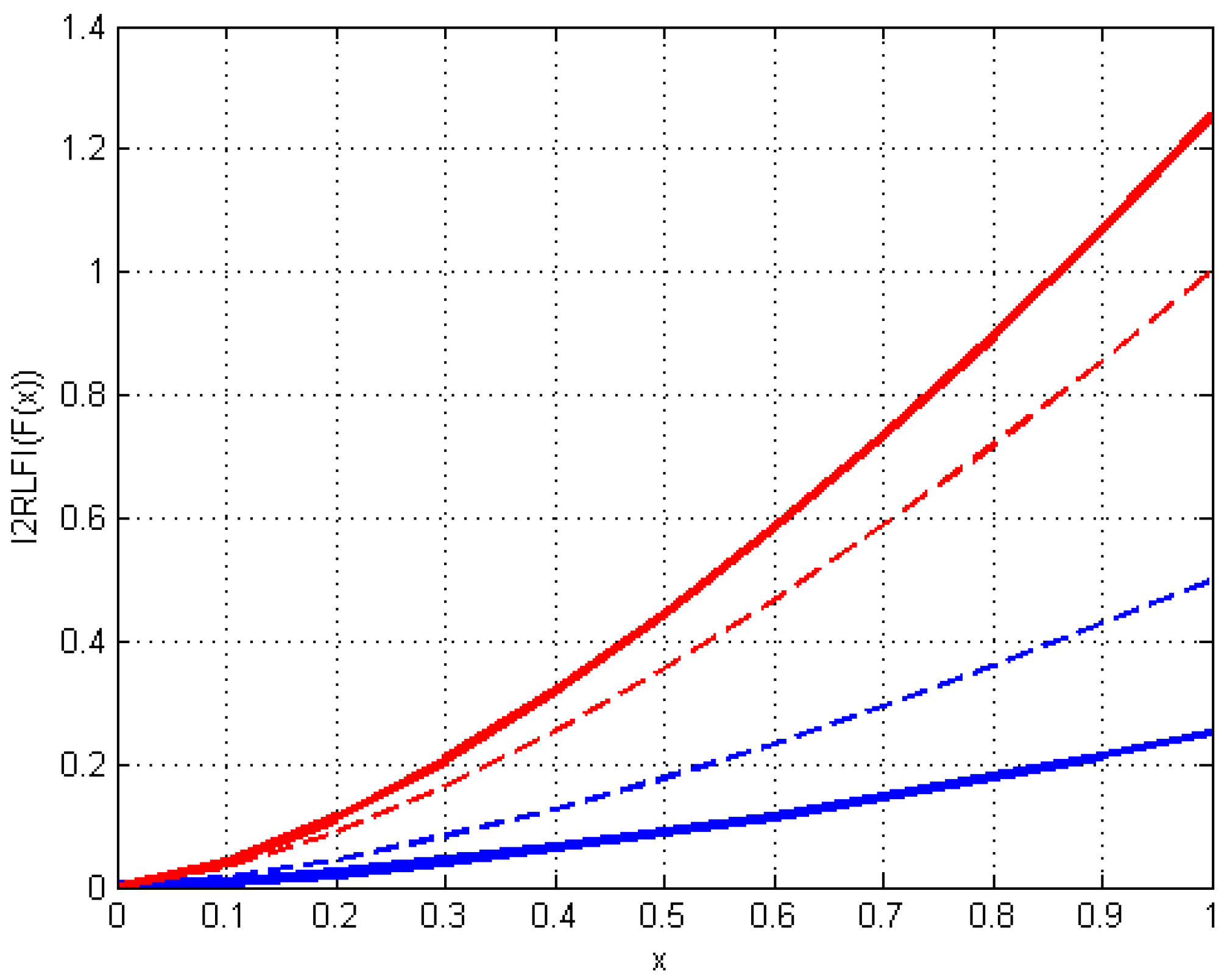
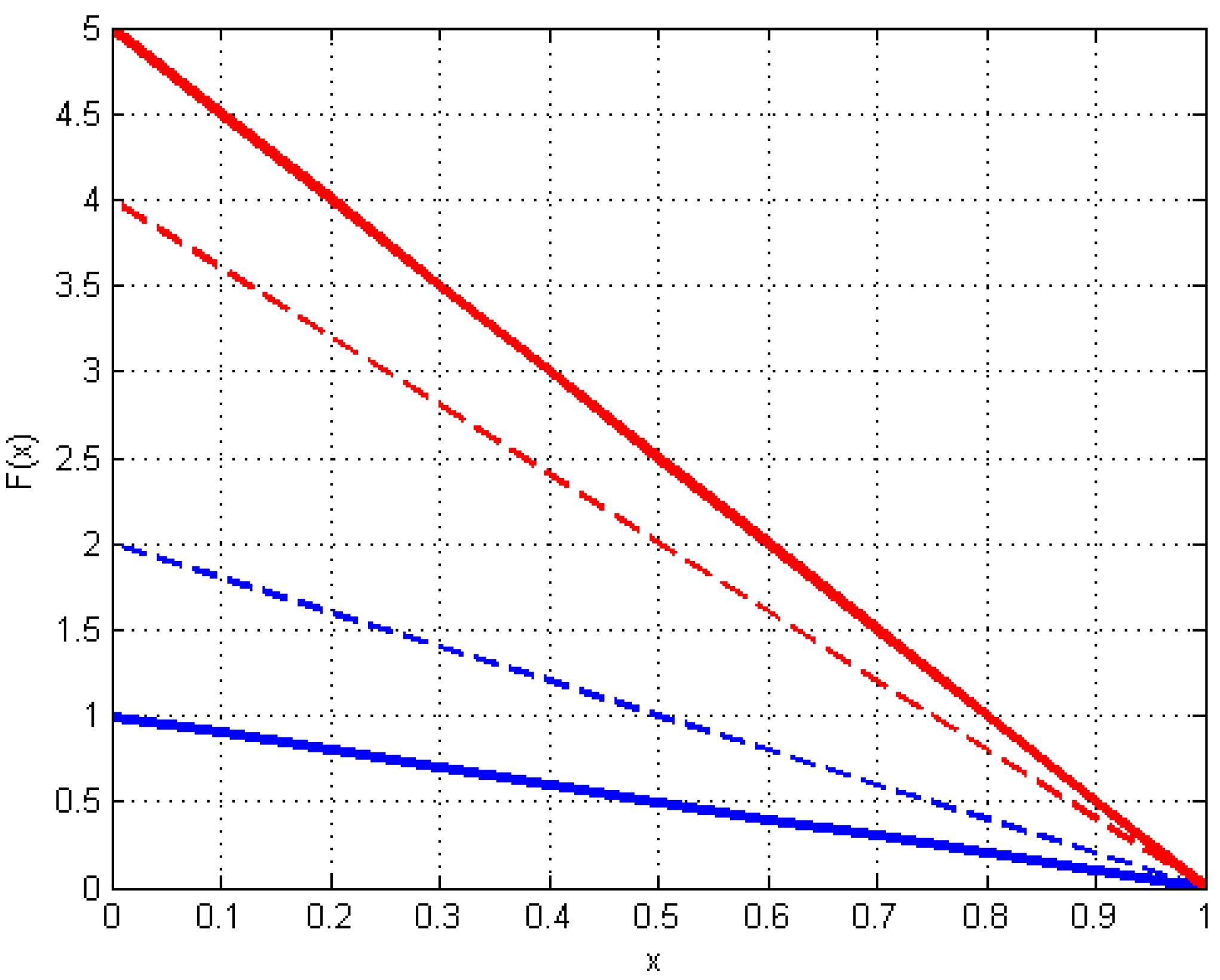


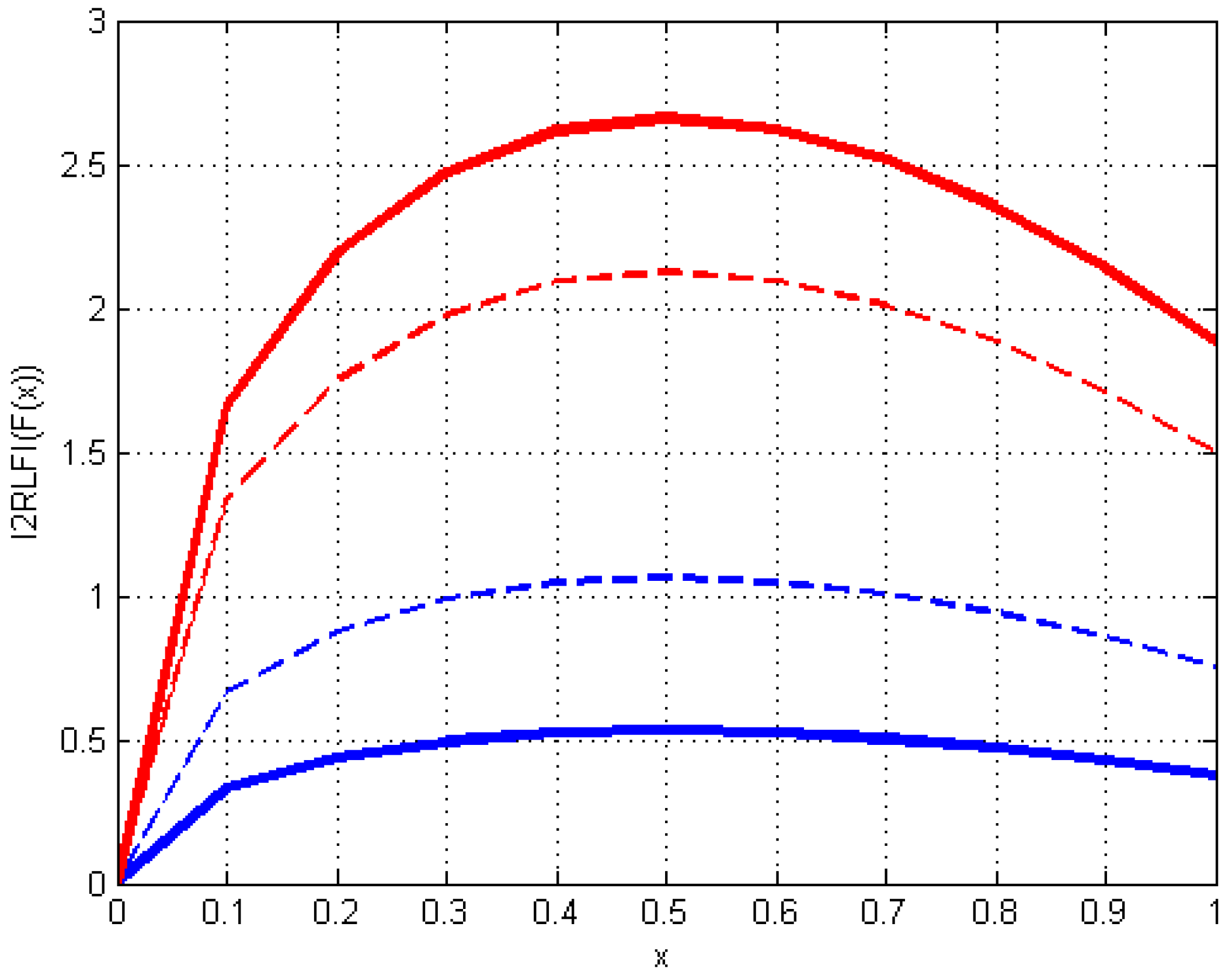
| Notation | Meaning |
|---|---|
| Demand (units) | |
| Selling price (USD/units) | |
| Inventory level at time | |
| Lot size (units) | |
| Total time cycle (month) (decision variable) | |
| Differential memory index (decision variables) | |
| Integral memory index (decision variables) | |
| Holding cost (per unit per unit time) | |
| Purchasing cost (per unit per unit time) | |
| Ordering cost (per complete cycle) | |
| Average profit (USD) (objective function) |
| α | |||
|---|---|---|---|
| 1 | 2.864 | [[837.85, 836.42], [830.69, 829.26]] | [[−636.39, −345.68], [827.15, 1122.86]] |
| 0.9 | 3.753 | [[1000.01, 998.30], [991.46, 989.75]] | [[−266.11, 24.81], [1198.50, 1494.42]] |
| 0.8 | 5.147 | [[1164.84, 1162.85], [1154.89, 1152.89]] | [[238.92, 530.34], [1706.02, 2002.44]] |
| 0.7 | 7.361 | [[1301.94, 1299.71], [1290.81, 1288.59]] | [[857.90, 1150.09], [2328.83, 2626.02]] |
| 0.6 | 10.98 | [[1378.45, 1376.09], [1366.67, 1364.31]] | [[1547.72, 1840.87], [3023.45, 3321.59]] |
| 0.5 | 17.252 | [[1370.89, 1368.54], [1359.17, 1356.83]] | [[2251.45, 2545.64], [3732.39, 4031.58]] |
| 0.4 | 29.254 | [[1272.17, 1269.99], [1261.30, 1259.12]] | [[2910.16, 3205.36], [4396.18, 4696.38]] |
| 0.3 | 56.315 | [[1092.18, 1090.31], [1082.84,1080.97]] | [[3473.64, 3769.73], [4964.09, 5265.19]] |
| 0.2 | 138.171 | [[853.66, 852.20], [846.37, 844.91]] | [[3907.59, 4204.38], [5401.53, 5703.31]] |
| 0.1 | 621.65 | [[584.98, 583.98], [579.98, 578.78]] | [[4196.77, 4494.03], [5693.06, 5995.31]] |
| β | |||
|---|---|---|---|
| 1 | 2.864 | [[837.85, 836.42], [830.69, 839.26]] | [[−636.39, −345.68], [827.15, 1122.86]] |
| 0.9 | 2.338 | [[], []] | [[−796.16, −518.34], [602.46, 885.04]] |
| 0.8 | 1.849 | [[540.71, 539.79], [536.09, 535.17]] | [[−959.19, −682.68], [432.84, 714.09]] |
| 0.7 | 1.413 | [[413.17, 412.46], [409.64, 408.93]] | [[−1127.79, −838.33], [329.45, 623.87]] |
| 0.6 | 1.034 | [[302.48, 301.96], [299.89, 299.37]] | [[−1310.72, −987.74], [315.23, 643.73]] |
| 0.5 | 0.709 | [[207.36, 207.01], [205.59, 205.24]] | [[−1536.33, −1143.03], [443.56, 843.56]] |
| 0.4 | 0.433 | [[126.54, 126.32], [125.46, 125.24]] | [[−1904.85, −1355.79], [859.05, 1417.42]] |
| 0.3 | 0.208 | [[60.94, 60.84], [60.42, 60.32]] | [[−2903.67, −1915.02], [2072.97, 3078.33]] |
| 0.2 | 0.055 | [[16.16, 16.14], [16.03, 16.00]] | [[−9295.04, −6014.63], [7217.44, 10553.10]] |
| 0.1 | 0.001 | [[0.39, 0.39], [0.39, 0.39]] | [[−481333.57, −361310.14], [122818.13, 244858.84]] |
| 1 | 2.684 | [[837.85, 836.42], [830.69, 829.26]] | [[−636.39, −345.68], [827.15, 1122.86]] |
| 0.9 | 3.035 | [[826.04, 824.62], [818.98, 817.56]] | [[−494.09, −223.39], [868.70, 1144.05]] |
| 0.8 | 3.171 | [[790.65, 789.30], [783.89, 782.54]] | [[−367.89, −119.17], [881.55, 1134.00]] |
| 0.7 | 3.196 | [[725.99, 724.75], [719.78, 718.54]] | [[−282.39, −56.02], [857.23, 1087.48]] |
| 0.6 | 3.043 | [[638.24, 637.14], [632.78, 631.69]] | [[−259.81, −50.59], [793.46, 1006.26]] |
| 0.5 | 2.731 | [[545.45, 544.52], [540.79, 539.86]] | [[−307.85, −108.48], [695.82, 898.61]] |
| 0.4 | 2.339 | [[463.14, 462.35], [459.18, 458.39]] | [[−422.70, −224.93], [572.91, 774.06]] |
| 0.3 | 1.922 | [[296.49, 395.81], [393.10, 392.42]] | [[−608.19, −402.02], [429.72, 639.42]] |
| 0.2 | 1.476 | [[344.35, 343.77], [341.41, 340.82]] | [[−912.02, −678.73], [262.39, 499.66]] |
| 0.1 | 0.891 | [[303.94, 303.42], [301.34, 300.82]] | [[−1690.78, −1349.80], [25.76, 372.57]] |
| 1 | 2.879 | [[833.55, 834.99], [840.74, 842.18]] | [[−677.16, −372.86], [854.33, 1163.63]] |
| 0.9 | 3.77 | [[993.87, 995.59], [1002.46, 1004.17]] | [[−305.60, −1.51], [1224.83, 1533.91]] |
| 0.8 | 5.168 | [[1156.59, 1158.59], [1166.58, 1168.58]] | [[202.42, 506.01], [1730.35, 2038.93]] |
| 0.7 | 7.386 | [[1291.69, 1293.92], [1302.85, 1205.08]] | [[826.01, 1128.83], [2350.09, 2657.91]] |
| 0.6 | 11.013 | [[1366.77, 1369.13], [1378.57, 1380.13]] | [[1521.59, 1823.45], [3040.87, 3347.73]] |
| 0.5 | 17.299 | [[1358.68, 1361.03], [1370.41, 1372.76]] | [[2231.58, 2532.39], [3745.64, 4051.45]] |
| 0.4 | 29.33 | [[1260.44, 1262.62], [1271.33, 1273.50]] | [[2896.38, 3196.18], [4405.36, 4710.16]] |
| 0.3 | 56.466 | [[1081.85, 1083.71], [1091.19, 1093.06]] | [[3465.18, 3764.09], [4969.73, 5273.64]] |
| 0.2 | 138.583 | [[845.41, 846.87], [852.71,854.17]] | [[3903.31,4201.52], [5404.38, 5707.59]] |
| 0.1 | 623.905 | [[579.19, 580.19], [584.19, 585.19]] | [[4195.31, 4493.06], [5694.03, 5996.77]] |
| 1 | 2.879 | [[833.55, 834.99], [840.74, 842.18]] | [[−677.16, −372.86], [854.33, 1163.63]] |
| 0.9 | 2.348 | [[679.61, 680.78], [685.48, 686.65]] | [[−833.44, −543.09], [627.87, 922.99]] |
| 0.8 | 1.854 | [[536.60, 537.53], [541.24, 542.16]] | [[−994.13, −705.82], [456.90, 749.95]] |
| 0.7 | 1.415 | [[409.63, 410.34], [413.17, 413.87]] | [[−1161.21, −860.45], [352.49, 658.20]] |
| 0.6 | 1.035 | [[299.67, 300.19], [302.26, 302.78]] | [[−1343.14, −1009.22], [337.51, 676.95]] |
| 0.5 | 0.709 | [[205.34, 205.70], [207.12, 207.47]] | [[−1568.06, −1164.08], [465.25, 875.94]] |
| 0.4 | 0.433 | [[125.27, 125.49], [126.35, 126.57]] | [[−1936.08, −1376.54], [880.29, 1449.15]] |
| 0.3 | 0.208 | [[60.32, 60.42], [60.84, 60.95]] | [[−2934.52, −1945.53], [2093.84, 3109.53]] |
| 0.2 | 0.055 | [[16.00, 16.03], [16.14, 16.17]] | [[−9325.58, −6034.95], [7237.99, 10583.83]] |
| 0.1 | 0.001 | [[0.39, 0.39], [0.39,0.39]] | [[−481363.83, −361330.30], [122838.39, 244889.21]] |
| 1 | 2.879 | [[833.55, 834.99], [840.74, 842.18]] | [[−677.16, −372.86], [854.33, 1163.63]] |
| 0.9 | 3.044 | [[819.66, 8221.08], [826.74, 828.15]] | [[−530.27, −247.50], [893.29, 1180.81]] |
| 0.8 | 3.168 | [[781.94, 783.29], [788.69, 790.04]] | [[−400.55, −141.53], [903.08, 1166.36]] |
| 0.7 | 3.175 | [[715.33, 716.56], [721.51, 722.74]] | [[−313.24, −77.03], [875.55, 1115.65]] |
| 0.6 | 3.005 | [[626.93, 628.01], [632.34, 633.42]] | [[−291.14, −72.57], [808.89, 1031.06]] |
| 0.5 | 2.681 | [[534.87, 535.80], [539.49, 540.42]] | [[−241.94, −133.13], [708.98, 921.24]] |
| 0.4 | 2.283 | [[453.91, 454.69], [457.83, 458.61]] | [[−462.50, −254.50], [584.33, 795.76]] |
| 0.3 | 1.86 | [[388.60, 389.27], [391.95, 392.63]] | [[−659.65, −441.25], [439.53, 661.53]] |
| 0.2 | 1.407 | [[337.58, 338.16], [340.49, 341.07]] | [[−992.82, −742.02], [269.47, 524.42]] |
| 0.1 | 0.812 | [[298.02, 298.53], [300.59, 301.11]] | [[−1912.01, −1528.32], [19.16, 409.20]] |
Disclaimer/Publisher’s Note: The statements, opinions and data contained in all publications are solely those of the individual author(s) and contributor(s) and not of MDPI and/or the editor(s). MDPI and/or the editor(s) disclaim responsibility for any injury to people or property resulting from any ideas, methods, instructions or products referred to in the content. |
© 2025 by the authors. Licensee MDPI, Basel, Switzerland. This article is an open access article distributed under the terms and conditions of the Creative Commons Attribution (CC BY) license (https://creativecommons.org/licenses/by/4.0/).
Share and Cite
Rahaman, M.; Chalishajar, D.; Gazi, K.H.; Alam, S.; Salahshour, S.; Mondal, S.P. Fractional Calculus for Type 2 Interval-Valued Functions. Fractal Fract. 2025, 9, 102. https://doi.org/10.3390/fractalfract9020102
Rahaman M, Chalishajar D, Gazi KH, Alam S, Salahshour S, Mondal SP. Fractional Calculus for Type 2 Interval-Valued Functions. Fractal and Fractional. 2025; 9(2):102. https://doi.org/10.3390/fractalfract9020102
Chicago/Turabian StyleRahaman, Mostafijur, Dimplekumar Chalishajar, Kamal Hossain Gazi, Shariful Alam, Soheil Salahshour, and Sankar Prasad Mondal. 2025. "Fractional Calculus for Type 2 Interval-Valued Functions" Fractal and Fractional 9, no. 2: 102. https://doi.org/10.3390/fractalfract9020102
APA StyleRahaman, M., Chalishajar, D., Gazi, K. H., Alam, S., Salahshour, S., & Mondal, S. P. (2025). Fractional Calculus for Type 2 Interval-Valued Functions. Fractal and Fractional, 9(2), 102. https://doi.org/10.3390/fractalfract9020102











